
 English
English
 French
French
The real conditions and the number of factors related to asthmatic patients in Quoc Tuan commune - An Lao district and Hong Thai commune - An Duong district in Hai Phong city - Vietnam
Les conditions réelles et le nombre de facteurs liés aux patients asthmatiques dans les communes de Quoc Tuan-district An Lao et de Hong Thai-district An Duong de la ville de Hai Phong-Viet Nam
Pham Huy Quyen1, Nguyen Quang Chinh2, Pham Thu Xanh2
1 ; Hai Phong University of Medicine and Pharmacy
2; Hai Phong Department of Health
Corresponding author
Dr. Pham Huy Quyen
Hai Phong University of Medicine and Pharmacy
Email: quyendhyhp@gmail.com
ABSTRACT
We conducted a cross-sectional survey in August 2013 on the status of bronchial asthma in Quoc Tuan community in An Lao district, Hong Thai commune, An Duong district, Hai Phong. By the total sampling method, the study conducted 4,477 families, 11,972 people over 16 years of age; 5,768 men and 6,204 women were surveyed directly in the household, combined with medical examination, detection and in-depth interviews of 455 patients. The results are: - The prevalence of asthma in adults is 3.80%, the proportion of women is higher than in men (3.54% and 4.05% p <0.05). The disease can occur at any age, patients with local allergy (38.0%) or with relatives with asthma (35.4%), asthma triggers appear Including allergies: weather change (83.7%), stress 48.6%, cold (41.1%), respiratory infections, smoke, dust, food .- Rate severe asthma in third and fourth grade patients accounted for 15.1%. The severity of asthma is related to male sex, over age 60, disease that lasts for more than 5 years, no prophylaxis and health education communication; The difference was statistically significant with p <0.05. Over age 60 and older tended to be less likely to have asthma control than those who were younger and had more controlled prophylaxis than non-drug users; The difference was statistically significant with p <0.05.
KEYWORDS: Asthma, asthmatic patients, asthma control, Hai Phong.
RÉSUMÉ
Nous avons mené une enquête transversale en août 2013 sur le statut de l'asthme dans la commune de Quoc Tuan du district de An Lao et la commune de Hong Thai du district de An Duong de la ville de Hai Phong. Selon la méthode d'échantillonnage totale, l'étude a porté sur 4 477 familles, soit 11 972 personnes de plus de 16 ans; 5 768 hommes et 6 204 femmes ont été interrogés directement chez eux, associés à un examen médical, à la détection et aussi pour les entretiens approfondis avec 455 patients. Les résultats sont les suivants: - La prévalence de l'asthme chez les adultes est de 3,8%, la proportion de femmes est supérieure à celle d'hommes (3,54% et 4,05% p <0,05). La maladie peut survenir à tout âge, chez les patients présentant une allergie locale (38,0%) ou chez des parents asthmatiques (35,4%), des déclencheurs d'asthme apparaissent. Incluant les allergies: changements climatiques (83,7%), stress 48,6%, rhume (41,1%), problèmes respiratoires. infections, fumée, poussière, nourriture. - Le taux d'asthme sévère chez les patients de troisième et quatrième années représentait 15,1%. La sévérité de l'asthme est liée au sexe masculin, à l'âge de plus de 60 ans, à une maladie qui dure depuis plus de 5 ans, à l'absence de prophylaxie et de communication en matière d'éducation pour la santé. La différence était statistiquement significative avec p <0,05. Les personnes de plus de 60 ans et plus avaient tendance à être moins susceptibles de contrôler leur asthme que celles qui étaient plus jeunes et avaient une prophylaxie mieux contrôlée que les non-utilisateurs de médicaments. La différence était statistiquement significative avec p <0,05.
MOTS CLÉS: Asthme, patients asthmatiques, contrôle de l’asthme, Hai Phong.
INTRODUCTION
Bronchial asthma (or asthma) is a global social disease, because of high incidence, rapid increase and affect the health and life of many people [1]. Vietnam does not have a comprehensive survey on the incidence of asthma in the whole country. Therefore, to study the situation of bronchial asthma, some factors related to the disease in the local, to timely propose reasonable solutions to strengthen the prevention and treatment of asthma control. As well as contributing to the prevention of chronic bronchial disease in general.
We conducted this study in Quoc Tuan commune, An Lao district and Hong Thai commune, An Duong district - Hai Phong city with the following objectives: 1) To identify the prevalence and characteristics of adult asthma in the two surveyed communes in 2013. 2) To describe some factors related to bronchial asthma in patients.
METHODES
Study subjects
Commune of Quoc Tuan - An Lao district; Hong Thai commune - An Duong district of Hai Phong city. Patients with asthma were included Study period: in August 2013.
Methods Research design
Methods of cross-sectional survey research. Basic data collection techniques include direct household interviews, in-patient interviews, clinical examination, peak expiratory flow measurements, and laboratory tests. The research tools include servey questionnaires, questionnaires, detail questionnaires developed for each target group, examining tools, peak flow meter.
Sample and sample selection
Sample size is determined by the formula for sample size for cross sectional study as describing below.

n is the sample size; Z21-a/2 is the confidence factor, which is 1.96 (corresponding to 95% confidence). The greatest variance of the study was compared with the actual one, taking e = 0.3.
Calculated according to the sample size of the sample of 1,380 people, in order to increase the reliability we surveyed all adults living in the commune with 11,972 adults > 16 years old. Sample selection: by the method of total sampling (list all households in the commune, then survey each household to the end).
Standard for selecting patients with asthma
All patients with asthma are present, through local surveys and visits. Diagnosis criteria for bronchial asthma (according to GINA 2008 guidelines for asthma diagnosis in the community): There are four symptoms in the present or in the past: signs of repeated difficulty breathing; repeated wheezing; persistent cough with white sputum recurrence; severe recurrent chest pain. Signs that occur in the same circumstances, such as weather changes, exertion, exposure to allergens, respiratory infections, difficulty breathing or appearing or heavy at night or early morning, may be spontaneously recovered without treatment. For the cases of with non-typical asthma when the patient has only persistent wheezing, persistent cough, recurrent severe chest oppression with a personal history of atopy, family with asthma or allergy, or when the symptoms happening it responds well to steroids or bronchodilators. They should do bronchial reversibility test; eliminate all the cases of difficulty breathing due to other causes.
Data analyze
Statistical method was done by SPSS software.
RESULTATS
Characteristics of asthmatic patients
Investigated by 11,972 people the results are presented in Table 1. The incidence of asthma in the two communes is 3.80%, there are significant differences between the two general sex and adults. Significant differences were found in the incidence of asthma among men and women (3.61% and 4.05%) p <0.05.
Economic life was good of 3.7%, average of 80.0%, 6.8% of patients were living near poor and 9.4% of patients were in poverty. A significant proportion of patients at the home was 15.8%. The percentage of planting tree in house was 15.2% (Table 6).
Patients with asthma or history of at least 1 other allergic asthma were 38.0%; the number of allergic rhinitis was 16.07%. The percentage of urtica/ pruritus was 28.1%; 35.4% patients had the relatives who also had asthma (Table 7).
There were 67.0% of asthma patients at any time of the day; occurs at night with 20.4% higher than at other times of the day (Figure 1).
Most patients present asthma attacks at any time of the year (71.0%); 19.1% had asthma symptoms in winter, higher than the rest (Figure 2).
DISCUSSION
The study showed that the rate of asthma in adults in two studied communes is 3.80%. Compared with other studies done by Nguyen Nang An in the Northern provinces, Pham Huy Quyen in Hong Bang district and An Duong district, Vu Minh Thuc in Lach Tray ward in Hai Phong, and Sy D.Q in Dalat, our results are similar to these reports [1,6,7,8]. There is no difference in the incidence of asthma in the two study communes with the other studies because of the chronic disease, so there is no difference in the area of study, the time of study, and the years of study [1]. The prevalence of asthma in adults in this study was 3.8%, with significant differences in rates of sex between men and women (3.54% male and 4.05% in female). This finding is consistent with other studies such as Nikon KN, Mc Fadden and in the literature [4]. Study on the level of culture of patients, the results show that the majority of patients with low educational level, lower secondary education accounted for 80.9%, a significant number of illiterate was up to 5.9%. The low level of general education of asthma patients may be due to illness that is not treated well, resulting in learning disability, dropouts, or medical expenses, which can lead to inability to invest in the study.
Current asthma patients with at least one other allergic manifestation were 38.0%, with the most common allergic pruritus or urtica was being 28.1%; rhinitis allergy 16.7%. This result shows that patients with bronchial asthma have obvious allergic conditions. The family allergy also appears in local asthma patients when they investigate family history of asthma and allergies: up to 35.4% of asthmatic patients have their relatives had asthma. This feature is also consistent with other authors and the literature [1,5,7] that reports about asthma. For asthma triggers or severe illnesses including allergens, the studied results show that sudden weather changes are the most common cause of asthma attacks (83.7%), followed by physical exertion 48.6%, and cold weather for 41.1%. Many studies have confirmed that respiratory allergens, environment conditions along with other stimulants, especially sudden weather changes, are the factors that trigger asthma attacks. Therefore, the asthmatic patient as well as the physician who receive administering asthmatic patients need to know to take necessary measures to prevent the disease to be exacerbated.
In view of the severity of local asthma patients as well as the complications left on those patients by severe asthma or by inadequate treatment, we found that 15.1% patients with severe asthma. This finding suggests that asthma occurs with more severe randomized features or may be a consequence of a lack of adequate knowledge and prevention measures of the patient and physicians in the local resources [7,8]. The severity of asthma is related to male sex, over 60 years of age, disease that lasts for more than 5 years, no prophylaxis and educational communication; the difference was statistically significant with p <0.05. Over age 60 and older, it tended to have less control of asthma than those with lower age group and had higher prophylaxis to control the disease than nondrug users; the difference was statistically significant with p <0.05. Thus, the aware of asthma prevention should be propaganda. The guidelines for patients to enhance control treatment and the appropriate support for each target group are needed to improve asthma control status.
CONCLUSION
The prevalence of bronchial asthma in the two communes is 3.80% with the percentage of women is higher than that of men (4.05% vs 3.54 and p <0.05). The rate of severe asthma in patients (grade III and IV) accounts for 15.1%. The history of allergy for individuals and families of asthma patients is quite common. There is 35.4% of patients with asthma have relatives with asthma and 38% allergic. There are rash and urticaria of 28.1% and allergic rhinitis of 16.7%. Asthma triggers most likely due to weather changes: Up to 83.7% of asthmatic asthma triggers are due to weather changes. Moreover, the severity of asthma is related to male sex, over 60 years of age, disease lasting more than 5 years, no prevention treatment, and not receive medical communication: the difference is statistically significant with p <0.05. Over age 60 and older tends to have less control of asthma than those with lower age group and had higher prophylaxis to control the disease than non-drug users: the difference was statistically significant with p <0.05. We suggest that 1) The interventions for bronchial asthma patients are required in the community due to the high incidence of asthma in the community; 2) Patients should be approached for the treatment of asthma control.
CONFLIT OF INTERESTS
The authors declare no conflict of interests for the present study.
REFERENCES
1. Nguyen Nang An. Bronchial asthma, some current issues of reasoning and practice. Hanoi Publishing House 2009.
2. Phan Quang Doan. Some common causes of bronchial asthma. Journal of Practical Medicine 2001; 44-46.
3. Dang Huong Giang. Epidemiological characteristics of bronchial asthma in children aged 13 - 14 years and effectiveness of intervention by health education in two districts of Hanoi, PhD thesis Central Epidemiology and Hygiene in 2014.
4. Pham Huy Quyen, Nguyen Minh Khoi, Vu Ngoc Hao. Research on the situation of bronchopneumonia in Hong Bang District, Hai Phong. Clinical Medicine 2003; 493: 162- 164
5. Pham Van Thuc. Bronchial asthma. Medical Publishing House 2011.
6. Sy .D.Q, Thanh Binh M.H. Prevalence of asthma and asthma - similar symptoms in Dalat Highlands, Vietnam, Singapore medical journal 2007;48(4) 294-303.
FIGURES - TABLES
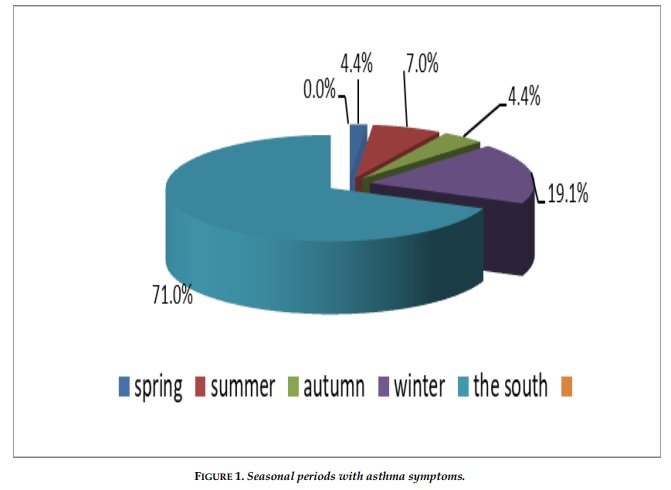
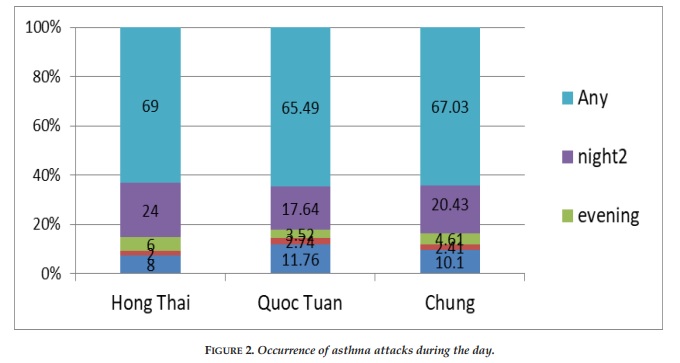
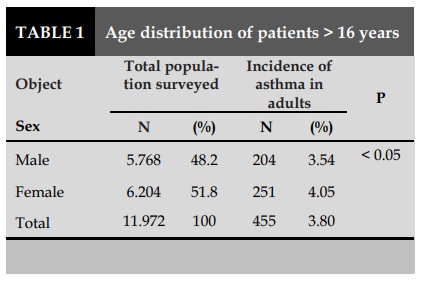
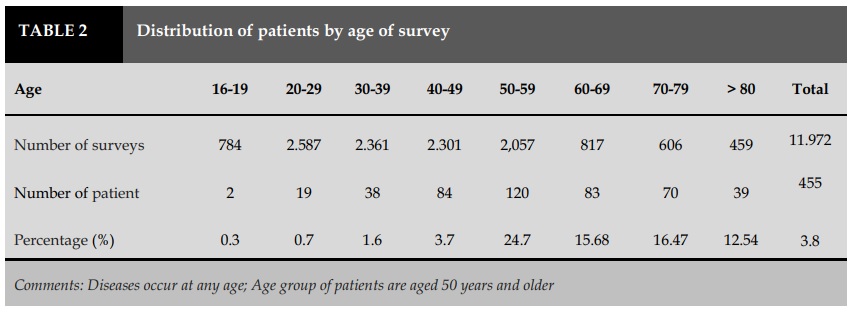

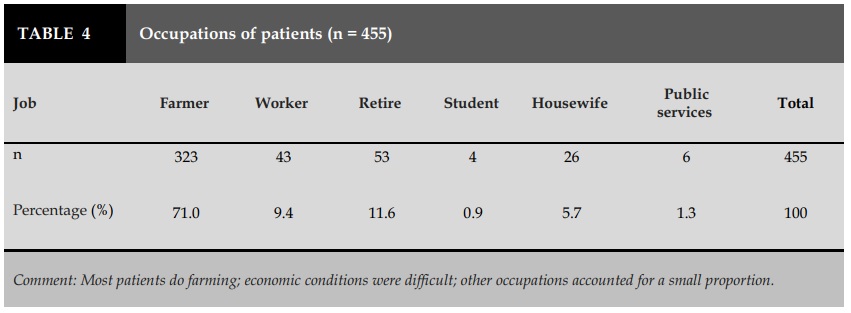

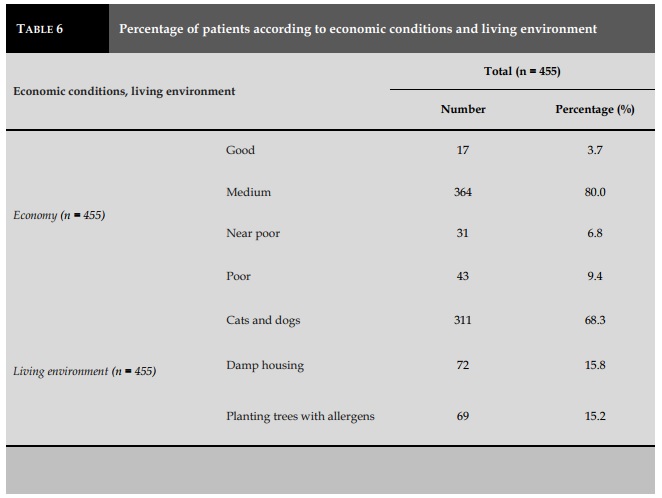
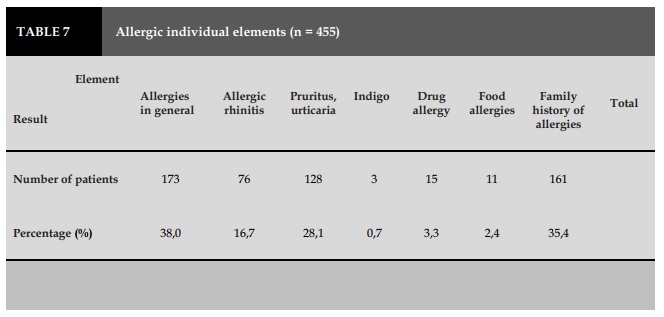
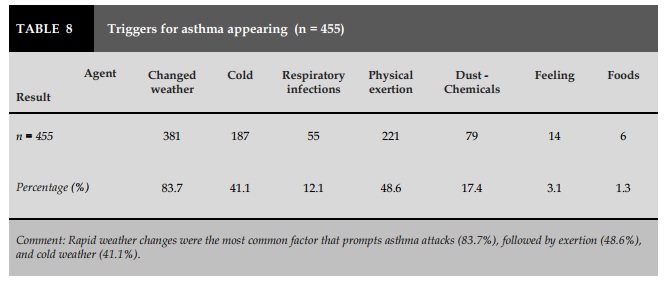
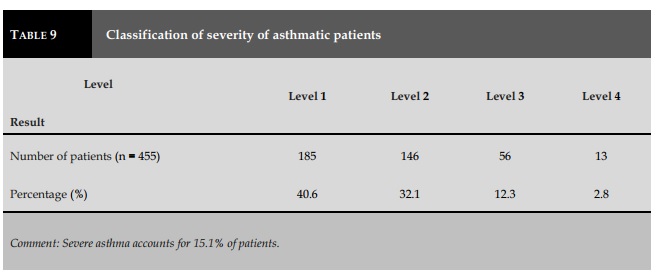
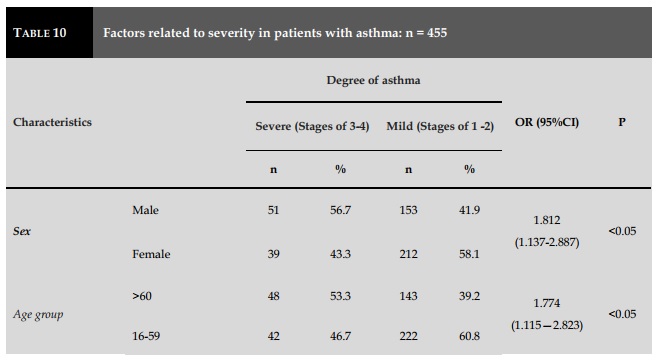
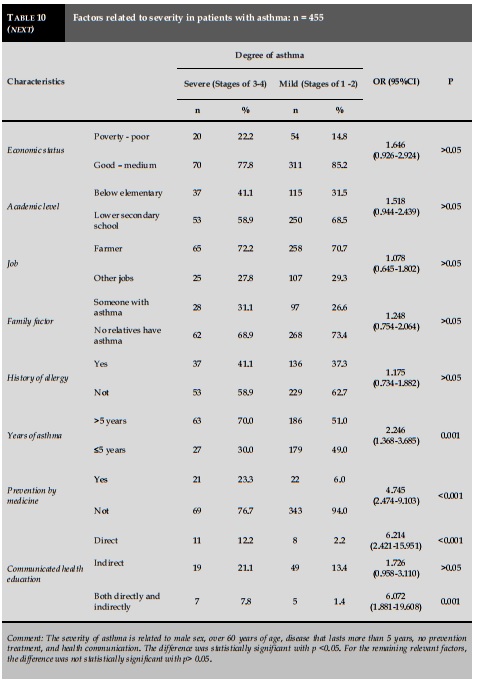
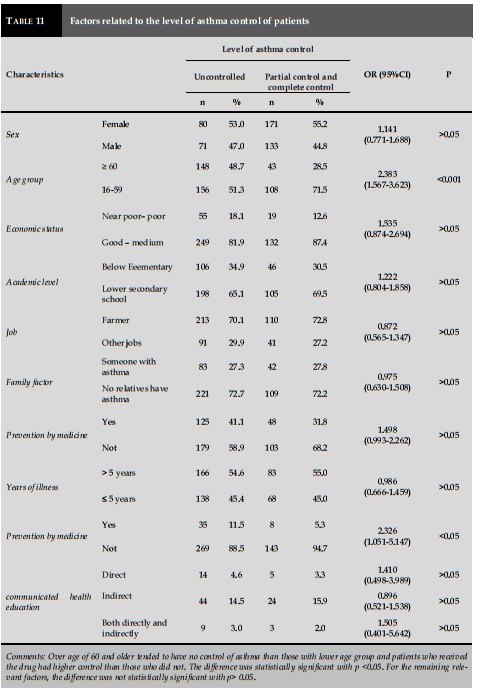
REFERENCES
1. Nguyen Nang An. Bronchial asthma, some current issues of reasoning and practice. Hanoi Publishing House 2009.
2. Phan Quang Doan. Some common causes of bronchial asthma. Journal of Practical Medicine 2001; 44-46.
3. Dang Huong Giang. Epidemiological characteristics of bronchial asthma in children aged 13 - 14 years and effectiveness of intervention by health education in two districts of Hanoi, PhD thesis Central Epidemiology and Hygiene in 2014.
4. Pham Huy Quyen, Nguyen Minh Khoi, Vu Ngoc Hao. Research on the situation of bronchopneumonia in Hong Bang District, Hai Phong. Clinical Medicine 2003; 493: 162- 164
5. Pham Van Thuc. Bronchial asthma. Medical Publishing House 2011.
6. Sy .D.Q, Thanh Binh M.H. Prevalence of asthma and asthma - similar symptoms in Dalat Highlands, Vietnam, Singapore medical journal 2007;48(4) 294-303.
ARTICLE INFO
DOI: 10.12699/jfvpulm.9.29.2018.1
Conflict of Interest
Non
Date of manuscript receiving
09/7/2018
Date of publication after correction
16/12/2018
Article citation
Huy Quyen Pham, Quang Chinh Nguyen, Thu Xanh Pham. The real conditions and the number of factors related to asthmatic patients in Quoc Tuan commune - An Lao district and Hong Thai commune - An Duong district in Hai Phong city - Vietnam. J Func Vent Pulm 2018;29(9):1-10.